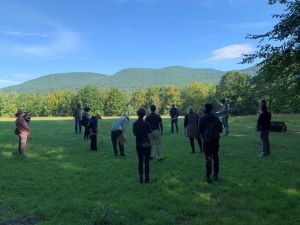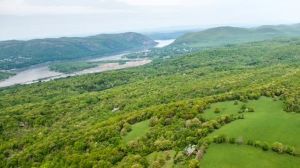In This Issue:
- Conserving Natural Areas: 2021 Highlights
- Connecting the Ecological Landscape
- Hundreds of Volunteers Help Thousands of Amphibians
- Taking the Long View By Protecting Scenery
Conserving Natural Areas: 2021 Highlights
 The varied geology of the Hudson River estuary watershed creates a tapestry of habitats, including streams, wetlands, grasslands, pine barrens, and mountain ranges. This mix of habitats gives the region exceptional importance and supports a high diversity of species of global and national significance. The varied geology of the Hudson River estuary watershed creates a tapestry of habitats, including streams, wetlands, grasslands, pine barrens, and mountain ranges. This mix of habitats gives the region exceptional importance and supports a high diversity of species of global and national significance.
The Hudson River Estuary Action Agenda 2021-2025 establishes a vision to conserve these important ecosystems with specific measures to track our success. Through science, educational programs, funding, and in-depth assistance, we help municipalities, land trusts, and conservation groups develop natural resources inventories (NRIs), open space plans, habitat connectivity studies, and other strategies that support clean water, wildlife, scenery, recreation, and climate adaptation. For two decades, DEC's Hudson River Estuary Program has collaborated with Cornell University Department of Natural Resources and the Environment to help achieve these conservation outcomes.
In 2021, hundreds of municipal officials and conservation professionals attended our monthly educational webinars and a small group attended our first in-person workshop since COVID-19. NRIs were completed in Beekman, Gardiner, Montgomery, New Paltz, Olive, Philipstown, Rensselaer, and Union Vale, and a growing number of communities used their NRIs to take further steps in conservation planning. Last month, DEC awarded $486,474 in Estuary Grants to continue this important work.
To learn more, visit Conservation and Land Use Planning on our website or check out the April 2021 article in Cornell Chronicle, Local Planners Play Key Role in Conserving Biodiversity.
Connecting the Ecological Landscape
 Preserving natural connections between habitats is critical for wildlife movement and climate adaptation. This year, with Estuary Grant funding, the Hudson Highlands Land Trust developed an intermunicipal plan for protecting important lands and waters across the Eastern Hudson Highlands landscape, a significant biodiversity area identified in our Wildlife and Habitat Conservation Framework (PDF). The Green Corridors Plan combines scientific study and habitat surveys; municipal input from NRIs and open space index priorities; and regional input from partners like the New York Highlands Network and Hudson-to-Housatonic. The plan will be a resource for decision-makers, landowners, residents, visitors, and conservation groups working in the region to preserve existing and future landscape connections that wildlife and people need to thrive in the Hudson Highlands. To learn more, visit the Hudson Highlands Land Trust website. (Photo courtesy of Lighthawk.) Preserving natural connections between habitats is critical for wildlife movement and climate adaptation. This year, with Estuary Grant funding, the Hudson Highlands Land Trust developed an intermunicipal plan for protecting important lands and waters across the Eastern Hudson Highlands landscape, a significant biodiversity area identified in our Wildlife and Habitat Conservation Framework (PDF). The Green Corridors Plan combines scientific study and habitat surveys; municipal input from NRIs and open space index priorities; and regional input from partners like the New York Highlands Network and Hudson-to-Housatonic. The plan will be a resource for decision-makers, landowners, residents, visitors, and conservation groups working in the region to preserve existing and future landscape connections that wildlife and people need to thrive in the Hudson Highlands. To learn more, visit the Hudson Highlands Land Trust website. (Photo courtesy of Lighthawk.)
Hundreds of Volunteers Help Thousands of Amphibians
 While our communities experienced many disruptions and challenges due to COVID-19, the Hudson Valley’s rich diversity of amphibians were unaffected. So, in mid-March, with temperatures on the rise and rain in the forecast, Amphibian Migrations & Road Crossings Project volunteers donned their raincoats, safety vests, and headlamps. They looked for wood frogs, spotted salamanders, and other amphibians that encountered roads on their nighttime journey from winter shelters in the forest to vernal pools, where they congregate for breeding each spring. This year, 404 volunteers—the highest participation since the project started in 2009—assisted more than 11,000 salamanders, frogs, and toads safely across roads. They counted 12,143 live amphibians and 4,599 dead amphibians on roads, and recorded weather and traffic conditions at all sites. Their dedicated efforts add to our understanding of migrations and habitat conservation needs and help to reduce amphibian mortality throughout the watershed. For more information, visit Amphibian Migrations and Road Crossings. (Photo by Amanda Simmonds.) While our communities experienced many disruptions and challenges due to COVID-19, the Hudson Valley’s rich diversity of amphibians were unaffected. So, in mid-March, with temperatures on the rise and rain in the forecast, Amphibian Migrations & Road Crossings Project volunteers donned their raincoats, safety vests, and headlamps. They looked for wood frogs, spotted salamanders, and other amphibians that encountered roads on their nighttime journey from winter shelters in the forest to vernal pools, where they congregate for breeding each spring. This year, 404 volunteers—the highest participation since the project started in 2009—assisted more than 11,000 salamanders, frogs, and toads safely across roads. They counted 12,143 live amphibians and 4,599 dead amphibians on roads, and recorded weather and traffic conditions at all sites. Their dedicated efforts add to our understanding of migrations and habitat conservation needs and help to reduce amphibian mortality throughout the watershed. For more information, visit Amphibian Migrations and Road Crossings. (Photo by Amanda Simmonds.)
Taking the Long View by Protecting Scenery
 Recognizing the connection between a thriving watershed ecosystem and beautiful scenery, the Estuary Program engages communities and partners to help them identify and protect beautiful natural areas. Our new Scenery Mapping and Planning page on our website highlights successful examples of scenery conservation by municipalities and provides a roadmap for anyone interested in protecting the region’s most visually stunning places. References like our newly published Scenic Resource Protection Guide (PDF) for the Hudson River Valley, made possible through a partnership with Cornell University’s Department of City and Regional Planning, provide a clear summary of methods for creating scenic resources inventories and effective tools for local scenery protection. In addition to this year’s virtual outreach on scenic view management, we completed two demonstration sites along the banks of the estuary. These sites provide dramatic Hudson River views while showcasing best practices for maintaining and enhancing the local ecology. For more information, refer to our handbook for landowners, Creating and Maintaining Hudson River Views (PDF). Recognizing the connection between a thriving watershed ecosystem and beautiful scenery, the Estuary Program engages communities and partners to help them identify and protect beautiful natural areas. Our new Scenery Mapping and Planning page on our website highlights successful examples of scenery conservation by municipalities and provides a roadmap for anyone interested in protecting the region’s most visually stunning places. References like our newly published Scenic Resource Protection Guide (PDF) for the Hudson River Valley, made possible through a partnership with Cornell University’s Department of City and Regional Planning, provide a clear summary of methods for creating scenic resources inventories and effective tools for local scenery protection. In addition to this year’s virtual outreach on scenic view management, we completed two demonstration sites along the banks of the estuary. These sites provide dramatic Hudson River views while showcasing best practices for maintaining and enhancing the local ecology. For more information, refer to our handbook for landowners, Creating and Maintaining Hudson River Views (PDF).

Conservationist Magazine Holiday Promotion
 Conservationist makes a great holiday gift for the whole family, subscribe now to get six issues for only $2 - Plus, the next issue (December/January) will feature a full size 2022 calendar with beautiful nature photography from across New York State. As an added bonus, Conservationist for Kids is included three times per year. Conservationist makes a great holiday gift for the whole family, subscribe now to get six issues for only $2 - Plus, the next issue (December/January) will feature a full size 2022 calendar with beautiful nature photography from across New York State. As an added bonus, Conservationist for Kids is included three times per year.
Gift a subscription of Conservationist to your friends and family.
|


 The varied geology of the Hudson River estuary watershed creates a tapestry of habitats, including streams, wetlands, grasslands, pine barrens, and mountain ranges. This mix of habitats gives the region exceptional importance and supports a high diversity of species of global and national significance.
The varied geology of the Hudson River estuary watershed creates a tapestry of habitats, including streams, wetlands, grasslands, pine barrens, and mountain ranges. This mix of habitats gives the region exceptional importance and supports a high diversity of species of global and national significance. Preserving natural connections between habitats is critical for wildlife movement and climate adaptation. This year, with Estuary Grant funding, the Hudson Highlands Land Trust developed an intermunicipal plan for protecting important lands and waters across the Eastern Hudson Highlands landscape, a significant biodiversity area identified in our
Preserving natural connections between habitats is critical for wildlife movement and climate adaptation. This year, with Estuary Grant funding, the Hudson Highlands Land Trust developed an intermunicipal plan for protecting important lands and waters across the Eastern Hudson Highlands landscape, a significant biodiversity area identified in our  While our communities experienced many disruptions and challenges due to COVID-19, the Hudson Valley’s rich diversity of amphibians were unaffected. So, in mid-March, with temperatures on the rise and rain in the forecast, Amphibian Migrations & Road Crossings Project volunteers donned their raincoats, safety vests, and headlamps. They looked for wood frogs, spotted salamanders, and other amphibians that encountered roads on their nighttime journey from winter shelters in the forest to vernal pools, where they congregate for breeding each spring. This year, 404 volunteers—the highest participation since the project started in 2009—assisted more than 11,000 salamanders, frogs, and toads safely across roads. They counted 12,143 live amphibians and 4,599 dead amphibians on roads, and recorded weather and traffic conditions at all sites. Their dedicated efforts add to our understanding of migrations and habitat conservation needs and help to reduce amphibian mortality throughout the watershed. For more information, visit
While our communities experienced many disruptions and challenges due to COVID-19, the Hudson Valley’s rich diversity of amphibians were unaffected. So, in mid-March, with temperatures on the rise and rain in the forecast, Amphibian Migrations & Road Crossings Project volunteers donned their raincoats, safety vests, and headlamps. They looked for wood frogs, spotted salamanders, and other amphibians that encountered roads on their nighttime journey from winter shelters in the forest to vernal pools, where they congregate for breeding each spring. This year, 404 volunteers—the highest participation since the project started in 2009—assisted more than 11,000 salamanders, frogs, and toads safely across roads. They counted 12,143 live amphibians and 4,599 dead amphibians on roads, and recorded weather and traffic conditions at all sites. Their dedicated efforts add to our understanding of migrations and habitat conservation needs and help to reduce amphibian mortality throughout the watershed. For more information, visit  Recognizing the connection between a thriving watershed ecosystem and beautiful scenery, the Estuary Program engages communities and partners to help them identify and protect beautiful natural areas. Our new
Recognizing the connection between a thriving watershed ecosystem and beautiful scenery, the Estuary Program engages communities and partners to help them identify and protect beautiful natural areas. Our new 
 Conservationist makes a great holiday gift for the whole family,
Conservationist makes a great holiday gift for the whole family,